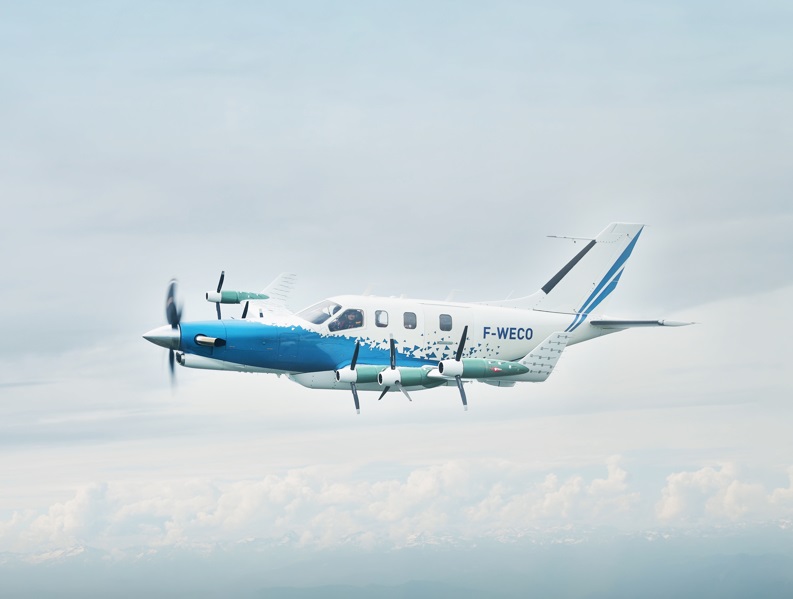
In today’s aviation industry, sustainability is more than a buzzword – it’s an operational imperative. For example, operators are increasingly turning to sustainable aviation fuel (SAF) to lower carbon emissions. At the same time, manufacturers are designing and building ever-more-efficient aircraft, and experimenting with electric, hydrogen and hybrid propulsion systems.
Eco-Pulse is one such experimental project. Eco-Pulse is a distributed-propulsion hybrid demonstration aircraft developed by Daher, Safran and Airbus with the support of France’s CORAC civil aviation research council. It’s a significant step toward achieving zero-carbon business aviation emissions by 2050, a core goal of the CLIMBING. FAST. advocacy initiative. It’s also a major milestone in Daher’s effort to bring a hybrid-electric aircraft to market by 2027.
“Eco-Pulse was designed to explore the viability of a variety of sustainability-driving aviation technologies,” said Christophe Robin, vice president of engineering and head of design at Daher. “The goal was to learn as much as possible about these technologies, and to speed their maturity.”
“Eco-Pulse was designed to explore the viability of a variety of sustainability-driving aviation technologies.”
Christophe Robin, Vice President of Engineering and Head of Design, Daher
Analyzing Viability of Hybrid-Electric Aircraft
Eco-Pulse modifies a Daher TBM airframe with an electric propulsion system from Safran, including six ePropellers, as well as aerodynamic optimization, flight control laws for the distributed propulsion system and a high-voltage battery from Airbus. With its maiden flight test in hybrid-electric mode in late 2023, from Daher’s European aircraft division headquarters in Tarbes, France, Eco-Pulse became a real-world demonstration that a single electrical source can power multiple electric motors distributed in positions throughout the aircraft, safely and at high levels of performance.
“We designed Eco-Pulse collaboratively and with as much complexity as possible in order to analyze the viability of, and accelerate the maturity of, a variety of sustainability-driving technologies,” said Robin. “Our hope is to accelerate decarbonization across general and commercial aviation, while positioning Daher as a sustainable-aviation pioneer.”
“We designed Eco-Pulse collaboratively and with as much complexity as possible in order to analyze the viability of, and accelerate the maturity of, a variety of sustainability-driving technologies.”
Christophe Robin, Vice President of Engineering and Head of Design, Daher
‘Different Aircraft Have Different Missions’
The distinct technical challenges, regulatory requirements and economic pressures of different aviation sectors make it probable that general aviation, rather than commercial aviation, will be where many sustainability-driving innovations first come to market and are adopted broadly.
But according to Robin, it would be a mistake to try to define a single, most-likely path to a more sustainable aviation future. Rather, what’s needed today is a broad-based effort exploring a wide range of approaches and technologies.
“Different aircraft have different missions. For lower-payload, shorter-distance travel, for example, electric power may be appropriate, while SAF and improved aerodynamic efficiency may be better solutions for heavier, longer-range flights. Meanwhile, clean-sheet design of brand-new aircraft offers the most possibility in terms of innovation – but going that route is expensive. Retrofitting existing aircraft provides a faster, easier path to certification,” explained Robin. “There is no one-size-fits-all answer in the push for greater sustainability. There is space for a wide range of solutions, and we need to be working on them all.”

“We couldn’t have designed or built Eco-Pulse without collaboration between Daher, Safran and Airbus. We shared research and aligned on roadmaps and key technologies.”
Christophe Robin, Vice President of Engineering and Head of Design, Daher
Technical Challenges
Of course, there are obstacles standing in the way of a speedy transformation to a more sustainable aviation future. These include technical challenges, like battery energy density, which must be significantly improved to make hybrid- and electric-powered flight more generally viable. But transforming the aviation industry will require much more than technology development. Achieving zero carbon emissions will require broad-based cooperation across stakeholders, including industry players and regulatory authorities – and across the entire lifecycle of aircraft, from design to certification to operation.
“We couldn’t have designed or built Eco-Pulse without collaboration between Daher, Safran and Airbus. We shared research and aligned on roadmaps and key technologies,” said Robin. “But that’s just the start of the kind of collaboration the industry needs to transform to a zero-carbon future.
“For example, manufacturers need to work hand-in-hand with regulatory authorities to prevent disconnects between technology development and the authorities’ ability to quickly certify innovative aircraft. And the entire industry needs to work together to put in place the necessary infrastructure to support aircraft powered by SAF, hydrogen and electric, as well as other sustainability-driving innovations,” Robin added. “After all, the best aircraft and technology in the world are worthless if operators can’t access the right parts or the right fuel when they need them.”

